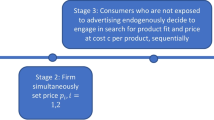Abstract
This paper studies a directed search model where sellers have limited capacities, and buyers cannot observe the varying number of advertisements each seller sends. In the presence of this asymmetric information, the limit purchase and selling probabilities as the market size increases are derived. The limit equilibrium is fully separating, where sellers with low advertisement intensity choose a lower price to signal. The equilibrium is not constrained inefficient, and equilibrium welfare is higher either when advertisements are highly costly or free. Buyers are better off in equilibrium than in the efficient allocation due to the lower price and benefit from more expensive advertisements.
Similar content being viewed by others
References
Albrecht, J., Gautier, P.A., Vroman, S.: Directed search in the housing market. Rev. Econ. Dyn. 19, 218–231 (2016)
Albrecht, J., Cai, X., Gautier, P., Vroman, S.: On the foundations of competitive search equilibrium with and without market makers. J. Econ. Theory 208, 105605 (2023)
Anenberg, E., Bayer, P.: Endogenous sources of volatility in housing markets: the joint buyer-seller problem. Int. Econ. Rev. 61(3), 1195–1228 (2020)
Bagwell, K.: The economic analysis of advertising. Handb. Ind. Organ. 3, 1701–1844 (2007)
Banks, J.S., Sobel, J.: Equilibrium selection in signaling games. Econometrica 55(3), 647–661 (1987)
Burdett, K., Shi, S., Wright, R.: Pricing and matching with frictions. J. Polit. Econ. 109(5), 1060–1085 (2001)
Butters, G.R.: Equilibrium distributions of sales and advertising prices. Rev. Econ. Stud. 44(3), 465–491 (1977)
Case, K.E., Shiller, R.J.: The efficiency of the market for single-family homes. Am. Econ. Rev. 79(1), 125–137 (1989)
Chang, B.: Adverse selection and liquidity distortion. Rev. Econ. Stud. 85(1), 275–306 (2017)
Cho, I.-K., Kreps, D.M.: Signaling games and stable equilibria. Q. J. Econ. 102(2), 179–221 (1987)
Delacroix, A., Shi, S.: Pricing and signaling with frictions. J. Econ. Theory 148(4), 1301–1332 (2013)
Ford, J.S., Rutherford, R.C., Yavas, A.: The effects of the internet on marketing residential real estate. J. Hous. Econ. 14(2), 92–108 (2005)
Gale, D.: Equilibria and Pareto optima of markets with adverse selection. Econ. Theory 7(2), 207–235 (1996). https://doi.org/10.1007/BF01213903
Galenianos, M., Kircher, P.: On the game-theoretic foundations of competitive search equilibrium. Int. Econ. Rev. 53(1), 1–21 (2012)
Gavazza, A., Mongey, S., Violante, G.L.: Aggregate recruiting intensity. Am. Econ. Rev. 108(8), 2088–2127 (2018)
Giacoletti, M.: Idiosyncratic risk in housing markets. Rev. Financ. Stud. 34(8), 3695–3741 (2021)
Glower, M., Haurin, D.R., Hendershott, P.H.: Selling time and selling price: the influence of seller motivation. Real Estate Econ. 26(4), 719–740 (1998)
Gomis-Porqueras, P., Julien, B., Wang, C.: Strategic advertising and directed search. Int. Econ. Rev. 58(3), 783–806 (2017)
Grossman, G.M., Shapiro, C.: Informative advertising with differentiated products. Rev. Econ. Stud. 51(1), 63–81 (1984)
Guerrieri, V., Shimer, R.: Dynamic adverse selection: a theory of illiquidity, fire sales, and flight to quality. Am. Econ. Rev. 104(7), 1875–1908 (2014)
Guerrieri, V., Shimer, R.: Markets with multidimensional private information. Am. Econ. J. Microecon. 10(2), 250–74 (2018)
Guerrieri, V., Shimer, R., Wright, R.: Adverse selection in competitive search equilibrium. Econometrica 78(6), 1823–1862 (2010)
Mailath, G.J., Okuno-Fujiwara, M., Postlewaite, A.: Belief-based refinements in signalling games. J. Econ. Theory 60(2), 241–276 (1993)
McAfee, R.P.: Mechanism design by competing sellers. Econometrica 61(6), 1281–1312 (1993)
Moen, E.R.: Competitive search equilibrium. J. Polit. Econ. 105(2), 385–411 (1997)
Peters, M.: Limits of exact equilibria for capacity constrained sellers with costly search. J. Econ. Theory 95(2), 139–168 (2000)
Pissarides, C.A.: Equilibrium Unemployment Theory. MIT Press, Cambridge (2000)
Robert, J., Stahl, D.O.: Informative price advertising in a sequential search model. Econometrica 61(3), 657–686 (1993)
Shi, S.: A directed search model of inequality with heterogeneous skills and skill-biased technology. Rev. Econ. Stud. 69(2), 467–491 (2002)
Shimer, R.: Search intensity. Technical report, mimeo, University of Chicago (2004)
Shimer, R.: The assignment of workers to jobs in an economy with coordination frictions. J. Polit. Econ. 113(5), 996–1025 (2005)
Wolthoff, R.: Applications and interviews: firms’ recruiting decisions in a frictional labour market. Rev. Econ. Stud. 85(2), 1314–1351 (2018)
Author information
Authors and Affiliations
Corresponding author
Additional information
Publisher's Note
Springer Nature remains neutral with regard to jurisdictional claims in published maps and institutional affiliations.
I thank the editor and two anonymous referees whose comments significantly improved the quality of this paper. I also thank John Kim, Junjie Guo, Seokjong Ryu, Soomin Jung and seminar participants at Asian Meeting of Econometric Society (2021), Chinese Meeting of Econometric Society (2021), and Chinese International Conference in Macroeconomics (2021) for their comments and suggestions. All errors are mine.
Rights and permissions
Springer Nature or its licensor (e.g. a society or other partner) holds exclusive rights to this article under a publishing agreement with the author(s) or other rightsholder(s); author self-archiving of the accepted manuscript version of this article is solely governed by the terms of such publishing agreement and applicable law.
About this article
Cite this article
Moon, JW. Hidden advertisement, signaling, and directed search. Econ Theory (2023). https://doi.org/10.1007/s00199-023-01542-9
Received:
Accepted:
Published:
DOI: https://doi.org/10.1007/s00199-023-01542-9




